Tracing Real-Time Transnational Hydrologic Sensitivity and Crop Irrigation in the Upper Rhine Area over the Exceptional Drought Episode 2018–2020 Using Open Source Sentinel-2 Data
Abstract
:1. Introduction
2. Material and Methods
2.1. Environmental Settings and Landscape History
2.2. Regional Governance and Irrigation Control 2020
2.3. Groundwater Height and River Rhine Water Level
2.4. Spatial Modelling Techniques and Quantitative Statistics
3. Results and Discussion
3.1. Crop Monitoring and Land-Use Differentiation
3.2. Temporal NDVI Series
3.3. Time Series Groundwater Level
3.4. Open Source Data Potential and Limitations
4. Conclusions
Author Contributions
Funding
Acknowledgments
Conflicts of Interest
References
- Lambin, E.F.; Geist, H. Land-Use and Land-Cover Change. Local Processes and Global Impacts; Springer-Verlag: Berlin/Heidelberg, Germany, 2006; ISBN 9783540322016. [Google Scholar]
- Buras, A.; Rammig, A.; Zang, C.S. Quantifying impacts of the 2018 drought on European ecosystems in comparison to 2003. Biogeosciences 2020, 17, 1655–1672. [Google Scholar] [CrossRef] [Green Version]
- Bréda, N.; Badeau, V. Forest tree responses to extreme drought and some biotic events: Towards a selection according to hazard tolerance? Comptes Rendus Geosci. 2008, 340, 651–662. [Google Scholar] [CrossRef]
- Blauhut, V.; Stahl, K.; Stagge, J.H.; Tallaksen, L.M.; Stefano, L.d.; Vogt, J. Estimating drought risk across Europe from reported drought impacts, hazard indicators and vulnerability factors. Hydrol. Earth Syst. Sci. Discuss. 2015, 12, 12515–12566. [Google Scholar] [CrossRef] [Green Version]
- Verburg, P.H.; Groot, W.T.d.; Veldkamp, A.J. Methodology for multi-scale land-use change modelling: Concepts and challenges. In Global Environmental Change and Land Use; Dolman, A.J., Verhagen, A., Rovers, C.A., Eds.; Springer Netherlands: Dordrecht, The Netherlands, 2003; pp. 17–51. ISBN 9789048163083. [Google Scholar]
- Crumley, C.L.; Marquardt, W.H. Landscape: A Unifying Concept in Regional Analysis. In Interpreting space: GIS and Archaeology; Allen, K.M., Green, S.W., Zubrow, E.B.W., Eds.; Taylor & Francis: London, UK, 1990; pp. 73–79. ISBN 0850668247. [Google Scholar]
- Baguette, M.; Blanchet, S.; Legrand, D.; Stevens, V.M.; Turlure, C. Individual dispersal, landscape connectivity and ecological networks. Biol. Rev. Camb. Philos. Soc. 2013, 88, 310–326. [Google Scholar] [CrossRef] [PubMed]
- Scholze, N.; Riach, N.; Glaser, R. Assessing Climate Change in the Trinational Upper Rhine Region: How Can We Operationalize Vulnerability Using an Indicator-Based, Meso-Scale Approach? Sustainability 2020, 12, 6323. [Google Scholar] [CrossRef]
- Labarchède, A.; Jong, C.d.; Giuglaris, É.; Dumont, S. Resilience of the Alsatian aquifer, France to Climate and Anthropogenic Change: A Case Study of the Grand Ried. Available online: https://meetingorganizer.copernicus.org/EGU2020/EGU2020-1178.html (accessed on 1 October 2020).
- Brèteau-Amores, S. Drought Effects on Early Growth and Mortality of Three Oak Species in the Upper Rhine Valley. AJCC 2018, 7, 336–354. [Google Scholar] [CrossRef] [Green Version]
- Tramberend, S.; Fischer, G.; Bruckner, M.; van Velthuizen, H. Our Common Cropland: Quantifying Global Agricultural Land Use from a Consumption Perspective. Ecol. Econ. 2019, 157, 332–341. [Google Scholar] [CrossRef] [Green Version]
- Zhang, X.; Wu, S.; Yan, X.; Chen, Z. A global classification of vegetation based on NDVI, rainfall and temperature. Int. J. Climatol. 2017, 37, 2318–2324. [Google Scholar] [CrossRef]
- Taylor, P.D.; Fahrig, L.; With, K.A. Landscape connectivity: A return to the basics. In Connectivity Conservation; Crooks, K.R., Sanjayan, M., Eds.; Cambridge University Press: Cambridge, MA, USA, 2006; pp. 29–43. ISBN 9780511754821. [Google Scholar]
- Taylor, P.D.; Fahrig, L.; Henein, K.; Merriam, G. Connectivity Is a Vital Element of Landscape Structure. Oikos 1993, 68, 571–573. [Google Scholar] [CrossRef] [Green Version]
- Anderson, S.J.; Kierepka, E.M.; Swihart, R.K.; Latch, E.K.; Rhodes, O.E. Assessing the permeability of landscape features to animal movement: Using genetic structure to infer functional connectivity. PLoS ONE 2015, 10, e0117500. [Google Scholar] [CrossRef] [Green Version]
- Li, Z.; Chen, H.; White, J.C.; Wulder, M.A.; Hermosilla, T. Discriminating treed and non-treed wetlands in boreal ecosystems using time series Sentinel-1 data. Int. J. Appl. Earth Obs. Geoinf. 2020, 85, 102007. [Google Scholar] [CrossRef]
- Endo, Y.; Halabisky, M.; Moskal, L.M.; Koshimura, S. Wetland Surface Water Detection from Multipath SAR Images Using Gaussian Process-Based Temporal Interpolation. Remote Sens. 2020, 12, 1756. [Google Scholar] [CrossRef]
- Verhulst, N.; Govaerts, B.; Sayre, K.D.; Deckers, J.; François, I.M.; Dendooven, L. Using NDVI and soil quality analysis to assess influence of agronomic management on within-plot spatial variability and factors limiting production. Plant Soil 2009, 317, 41–59. [Google Scholar] [CrossRef]
- Mleczko, M.; Mróz, M. Wetland Mapping Using SAR Data from the Sentinel-1A and TanDEM-X Missions: A Comparative Study in the Biebrza Floodplain (Poland). Remote Sens. 2018, 10, 78. [Google Scholar] [CrossRef] [Green Version]
- Kaplan, G.; Avdan, U. Mapping and monitoring wetlands using Sentinel-2 satellite imagery. ISPRS Ann. Photogramm. Remote Sens. Spatial Inf. Sci. 2017, IV-4/W4, 271–277. [Google Scholar] [CrossRef] [Green Version]
- Pulvirenti, L.; Squicciarino, G.; Fiori, E.; Fiorucci, P.; Ferraris, L.; Negro, D.; Gollini, A.; Severino, M.; Puca, S. An Automatic Processing Chain for Near Real-Time Mapping of Burned Forest Areas Using Sentinel-2 Data. Remote Sens. 2020, 12, 674. [Google Scholar] [CrossRef] [Green Version]
- Madruga de Brito, M.; Kuhlicke, C.; Marx, A. Near-real-time drought impact assessment: A text mining approach on the 2018/19 drought in Germany. Environ. Res. Lett. 2020, 15, 1040a9. [Google Scholar] [CrossRef]
- Le Page, M.; Toumi, J.; Khabba, S.; Hagolle, O.; Tavernier, A.; Kharrou, M.; Er-Raki, S.; Huc, M.; Kasbani, M.; Moutamanni, A.; et al. A Life-Size and Near Real-Time Test of Irrigation Scheduling with a Sentinel-2 Like Time Series (SPOT4-Take5) in Morocco. Remote Sens. 2014, 6, 11182–11203. [Google Scholar] [CrossRef] [Green Version]
- Kempf, M. Modelling multivariate landscape affordances and functional ecosystem connectivity in landscape archaeology. Archaeol. Anthropol. Sci. 2020, 12. [Google Scholar] [CrossRef]
- Caballero, I.; Ruiz, J.; Navarro, G. Sentinel-2 Satellites Provide Near-Real Time Evaluation of Catastrophic Floods in the West Mediterranean. Water 2019, 11, 2499. [Google Scholar] [CrossRef] [Green Version]
- Wieland, M.; Martinis, S. Large-scale surface water change observed by Sentinel-2 during the 2018 drought in Germany. Int. J. Remote Sens. 2020, 41, 4742–4756. [Google Scholar] [CrossRef]
- Vrieling, A.; Meroni, M.; Darvishzadeh, R.; Skidmore, A.K.; Wang, T.; Zurita-Milla, R.; Oosterbeek, K.; O’Connor, B.; Paganini, M. Vegetation phenology from Sentinel-2 and field cameras for a Dutch barrier island. Remote Sens. Environ. 2018, 215, 517–529. [Google Scholar] [CrossRef]
- Malenovský, Z.; Rott, H.; Cihlar, J.; Schaepman, M.E.; García-Santos, G.; Fernandes, R.; Berger, M. Sentinels for science: Potential of Sentinel-1, -2, and -3 missions for scientific observations of ocean, cryosphere, and land. Remote Sens. Environ. 2012, 120, 91–101. [Google Scholar] [CrossRef]
- Chrysafis, I.; Mallinis, G.; Siachalou, S.; Patias, P. Assessing the relationships between growing stock volume and Sentinel-2 imagery in a Mediterranean forest ecosystem. Remote Sens. Lett. 2017, 8, 508–517. [Google Scholar] [CrossRef]
- Ansper, A.; Alikas, K. Retrieval of Chlorophyll a from Sentinel-2 MSI Data for the European Union Water Framework Directive Reporting Purposes. Remote Sens. 2019, 11, 64. [Google Scholar] [CrossRef] [Green Version]
- Abate, N.; Elfadaly, A.; Masini, N.; Lasaponara, R. Multitemporal 2016-2018 Sentinel-2 Data Enhancement for Landscape Archaeology: The Case Study of the Foggia Province, Southern Italy. Remote Sens. 2020, 12, 1309. [Google Scholar] [CrossRef] [Green Version]
- Hari, V.; Rakovec, O.; Markonis, Y.; Hanel, M.; Kumar, R. Increased future occurrences of the exceptional 2018–2019 Central European drought under global warming. Sci. Rep. 2020, 10, 382. [Google Scholar] [CrossRef]
- Glaser, R.; Kahle, M. Reconstructions of droughts in Germany since 1500–combining hermeneutic information and instrumental records in historical and modern perspectives. Clim. Past 2020, 16, 1207–1222. [Google Scholar] [CrossRef]
- Stork, M.; Menzel, L. Analysis and simulation of the water and energy balance of intense agriculture in the Upper Rhine valley, south-west Germany. Environ. Earth Sci. 2016, 75, 57. [Google Scholar] [CrossRef]
- Martin, B.; Giacona, F.; Furst, B.; Edelblutte, C.; Holleville, N.; With, L.; Heitz, C.; Glaser, R.; Himmelsbach, I.; Schönbein, J.; et al. La variabilité spatio-temporelle des inondations dans le Fossé rhénan à la lumière de l’évolution de la vulnérabilité. VertigO La revue électronique en sciences de l’environnement 2017, 17. [Google Scholar] [CrossRef]
- Kempf, M. Fables of the past: Landscape (Re-)constructions and the Bias in the Data. Documenta Praehistorica. 2020. Available online: https://link.springer.com/article/10.1007/s12520-020-01127-w (accessed on 1 October 2020).
- Kempf, M. The designed landscape: Spatial concepts of human-environmental interactions in Early Medieval southern Germany. In Human-Made Environments-The Development of Landscapes as Resource Assemblages; Bartelheim, M., Garcia Sanjuan, L., Hardenberg, R., Eds.; University of Tübingen: Tübingen, Germany, 2021; (forthcoming). [Google Scholar]
- Koltzer, N.; Scheck-Wenderoth, M.; Cacace, M.; Frick, M.; Bott, J. Regional hydraulic model of the Upper Rhine Graben. Adv. Geosci. 2019, 49, 197–206. [Google Scholar] [CrossRef] [Green Version]
- Kempf, M. Paradigm and pragmatism: GIS-based spatial analyses of Roman infrastructure networks and land-use concepts in the Upper Rhine Valley. Geoarchaeology 2019, 74, 1–12. [Google Scholar] [CrossRef]
- Kempf, M. Migration or landscape fragmentation in Early Medieval eastern France? A case study from Niedernai. J. Archaeol. Sci. Rep. 2018, 21, 593–605. [Google Scholar] [CrossRef]
- Himmelsbach, I.; Glaser, R.; Schoenbein, J.; Riemann, D.; Martin, B. Reconstruction of flood events based on documentary data and transnational flood risk analysis of the Upper Rhine and its French and German tributaries since AD 1480. Hydrol. Earth Syst. Sci. 2015, 19, 4149–4164. [Google Scholar] [CrossRef] [Green Version]
- Himmelsbach, I.; Glaser, R.; Schoenbein, J.; Riemann, D.; Martin, B. Flood risk along the upper Rhine since AD 1480. Hydrol. Earth Syst. Sci. Discuss. 2015, 12, 177–211. [Google Scholar] [CrossRef]
- Giacona, F.; Martin, B.; Furst, B.; Glaser, R.; Eckert, N.; Himmelsbach, I.; Edelblutte, C.; Christiany, L. Improving the understanding of flood risk in the Alsatian region by knowledge capitalization: The ORRION participative observatory. Nat. Hazards Earth Syst. Sci. Discuss. 2018, 1–49. [Google Scholar] [CrossRef] [Green Version]
- Casper, M.C.; Vohland, M. Validation of a large scale hydrological model with data fields retrieved from reflective and thermal optical remote sensing data–A case study for the Upper Rhine Valley. Phys. Chem. Earth 2008, 17–18, 1061–1067. [Google Scholar] [CrossRef]
- Haidu, I.; Nistor, M.-M. Groundwater vulnerability assessment in the Grand Est region, France. Quat. Int. 2019. [Google Scholar] [CrossRef]
- Menzies, J.; Ellwanger, D. Climate and paleo-environmental change within the Mannheim Formation near Heidelberg, Upper Rhine Valley, Germany: A case study based upon microsedimentological analyses. Quat. Int. 2015, 386, 137–147. [Google Scholar] [CrossRef]
- Kempf, M. The application of GIS and satellite imagery in archaeological land-use reconstruction: A predictive model? J. Archaeol. Sci. Rep. 2019, 25, 116–128. [Google Scholar] [CrossRef]
- Asselman, N.E.M.; Middelkoop, H.; van Dijk, P.M. The impact of changes in climate and land use on soil erosion, transport and deposition of suspended sediment in the River Rhine. Hydrol. Process. 2003, 17, 3225–3244. [Google Scholar] [CrossRef]
- Glaser, R. Klimageschichte Mitteleuropas. 1200 Jahre Wetter, Klima, Katastrophen, 3. Auflage; WBG Wissenschaftliche Buchgesellschaft: Darmstadt, Germany, 2013; ISBN 9783534261741. [Google Scholar]
- Erfurt, M.; Glaser, R.; Blauhut, V. Changing impacts and societal responses to drought in southwestern Germany since 1800. Reg. Environ. Chang. 2019, 19, 2311–2323. [Google Scholar] [CrossRef] [Green Version]
- Scholze, N.; Glaser, R.; Roy, S. Klimavulnerabilität von Unternehmen in der Metropolregion Oberrhein und ihre Visualisierung anhand von Wirkpfaden. Revue d‘Allemagne et Des pays de Langue Allemande 2018, 50, 325–335. [Google Scholar] [CrossRef] [Green Version]
- Riach, N.; Scholze, N.; Glaser, R.; Roy, S.; Stern, B. Klimawandel am Oberrhein: Ein Zweisprachiges Dossier mit 24 Karten und 6 Begleittexten/Changement Climatique Dans le Rhin Superieur: un Dossier Bilingue avec 24 Cartes et 6 textes D’accompagnement 2019. Available online: http://www.georhena.eu/de/Kartensammlung (accessed on 1 October 2020).
- Glaser, R.; Scholze, N.; Jergentz, S. Klimavulnerabilität. In Geographie: Physische Geographie und Humangeographie; Gebhardt, H., Glaser, R., Radtke, U., Reuber, P., Vött, A., Eds.; Springer: New York, NY, USA, 2020; pp. 324–330. [Google Scholar]
- Tischendorf, L.; Fahrig, L. How should we measure landscape connectivity? Landscape Ecol. 2000, 15, 633–641. [Google Scholar] [CrossRef]
- Tischendorf, L.; Fahrig, L. On the usage and measurement of landscape connectivity. Oikos 2000, 90, 7–19. [Google Scholar] [CrossRef] [Green Version]
- Taylor, K. Landscape and meaning: Context for a global discourse on cultural landscape values. In Managing Cultural Landscapes; Taylor, K., Lennon, J., Eds.; Routledge: London, UK, 2012; pp. 21–44. ISBN 9780415672252. [Google Scholar]
- Kempf, M. From landscape affordances to landscape connectivity: Contextualizing an archaeology of human ecology. Archaeol. Anthropol. Sci. 2020, 12, 310. [Google Scholar] [CrossRef]
- van Loon, A.F.; Stahl, K.; Di Baldassarre, G.; Clark, J.; Rangecroft, S.; Wanders, N.; Gleeson, T.; van Dijk, A.I.J.M.; Tallaksen, L.M.; Hannaford, J.; et al. Drought in a human-modified world: Reframing drought definitions, understanding, and analysis approaches. Hydrol. Earth Syst. Sci. 2016, 20, 3631–3650. [Google Scholar] [CrossRef] [Green Version]
- Renner, R.; Schneider, F.; Hohenwallner, D.; Kopeinig, C.; Kruse, S.; Lienert, J.; Link, S.; Muhar, S. Meeting the Challenges of Transdisciplinary Knowledge Production for Sustainable Water Governance. Mt. Res. Dev. 2013, 33, 234–247. [Google Scholar] [CrossRef] [Green Version]
- Kruse, S.; Seidl, I. Social capacities for drought risk management in Switzerland. Nat. Hazards Earth Syst. Sci. 2013, 13, 3429–3441. [Google Scholar] [CrossRef] [Green Version]
- Minářová, J.; Müller, M.; Clappier, A. Seasonality of mean and heavy precipitation in the area of the Vosges Mountains: Dependence on the selection criterion. Int. J. Climatol. 2017, 37, 2654–2666. [Google Scholar] [CrossRef]
- Minářová, J.; Müller, M.; Clappier, A.; Kašpar, M. Characteristics of extreme precipitation in the Vosges Mountains region (north-eastern France). Int. J. Climatol 2017, 37, 4529–4542. [Google Scholar] [CrossRef]
- Hellwig, J.; Graaf, I.E.M.d.; Weiler, M.; Stahl, K. Large-Scale Assessment of Delayed Groundwater Responses to Drought. Water Resour. Res. 2020, 56. [Google Scholar] [CrossRef] [Green Version]
- Erfurt, M.; Skiadaresis, G.; Tijdeman, E.; Blauhut, V.; Bauhus, J.; Glaser, R.; Schwarz, J.; Tegel, W.; Stahl, K. Exploring the added value of a long-term multidisciplinary dataset in drought research–a drought catalogue for southwestern Germany dating back to 1801. Nat. Hazards Earth Syst. Sci. Discuss. 2020. [Google Scholar] [CrossRef] [Green Version]
- Averbeck, P.; Frör, O.; Gartiser, N.; Lützel, N.; Rudolf, F. Climate change preparedness of enterprises in the Upper Rhine region from a business perspective—A multidisciplinary, transboundary analysis. NachhaltigkeitsManagementForum 2019, 27, 83–93. [Google Scholar] [CrossRef] [Green Version]
- Preusser, F.; May, J.-H.; Eschbach, D.; Trauerstein, M.; Schmitt, L. Infrared stimulated luminescence dating of 19th century fluvial deposits from the upper Rhine River. Geochronometria 2016, 43, 131–142. [Google Scholar] [CrossRef] [Green Version]
- Preusser, F. Characterisation and evolution of the River Rhine system. Neth. J. Geosci. 2008, 87, 7–19. [Google Scholar] [CrossRef] [Green Version]
- Lehmkuhl, F.; Zens, J.; Krauß, L.; Schulte, P.; Kels, H. Loess-paleosol sequences at the northern European loess belt in Germany: Distribution, geomorphology and stratigraphy. Quat. Sci. Rev. 2016, 153, 11–30. [Google Scholar] [CrossRef]
- Schmitt, L.; Maire, G.; Nobelis, P.; Humbert, J. Quantitative morphodynamic typology of rivers: A methodological study based on the French Upper Rhine basin. Earth Surf. Process. Landf. 2007, 32, 1726–1746. [Google Scholar] [CrossRef]
- Przyrowski, R.; Schäfer, A. Quaternary fluvial basin of northern Upper Rhine Graben. Zeitschrift der Dtsch. Ges. für Geowiss. 2015, 166, 71–98. [Google Scholar] [CrossRef]
- Carbiener, R.; Schnitzler, A. Evolution of major pattern models and processes of alluvial forest of the Rhine in the rift valley (France/Germany). Vegetatio 1990, 88, 115–129. [Google Scholar] [CrossRef]
- Martin, B.; Himmelsbach, I.; Glaser, R.; With, L.; Guerrouah, O. French–German flood risk geohistory in the Rhine Graben. International Disaster Risk Conference, Davos 2010. hal-00530788. Available online: https://halshs.archives-ouvertes.fr/hal-00530788/ (accessed on 1 October 2020).
- Mischka, D. Methodische Aspekte zur Rekonstruktion prähistorischer Siedlungsmuster. Landschaftsgenese vom Ende des Neolithikums bis zur Eisenzeit im Gebiet des südlichen Oberrheins; Zugl.: Freiburg (Breisgau), Univ., Diss., 2004; Leidorf: Rahden, Westfalen, Germany, 2007; ISBN 9783896467935. Available online: https://journals.ub.uni-heidelberg.de/index.php/bjb/article/view/36130 (accessed on 1 October 2020).
- Koehler, H.; Angevin, R.; Bignon-Lau, O.; Griselin, S. Découverte de plusieurs occupations du Paléolithique supérieur récent dans le Sud de l’Alsace. Bulletin de la Société Préhistorique Française 2013, 110, 356–359. [Google Scholar] [CrossRef]
- Faustmann, A.C. Besiedlungswandel im südlichen Oberrheingebiet von der Römerzeit bis zum Mittelalter; Zugl.: Freiburg (Breisgau) Univ., Diss., 2005; Leidorf: Rahden, Westfalen, Germany, 2007; ISBN 9783896467706. Available online: https://www.vml.de/d/detail.php?ISBN=978-3-89646-770-6&hl=faustmann (accessed on 1 October 2020).
- Brönnimann, D.; Wimmer, J.; Müller-Kissing, M.; Stopp, B.; Rissanen, H.; Spichtig, N. One man’s trash is another man’s treasure. Interdisciplinary examination of taphonomic aspects of ceramic sherds, animal bones and sediments from the La Tène period settlement at Basel-Gasfabrik. PLoS ONE 2020, 15, e0236272. [Google Scholar] [CrossRef] [PubMed]
- Blöck, L.A. Die römerzeitliche Besiedlung im Rechten Südlichen Oberrheingebiet; Dissertation; Dr. Ludwig Reichert Verlag: Wiesbaden, Germany, 2016; ISBN 9783954902156. [Google Scholar]
- Mäckel, R.; Schneider, R.; Seidel, J. Anthropogenic Impact on the Landscape of Southern Badenia (Germany) During the Holocene—Documented by Colluvial and Alluvial Sediments. Archaeometry 2003, 45, 487–501. [Google Scholar] [CrossRef]
- Mäckel, R.; Schneider, R.; Friedmann, A.; Seidel, J. Environmental changes and human impact on the relief development in the Upper Rhine valley and Black Forest (South-West germany) during the Holocene. Zeitschrift für Geomorphologie N.F. 2002, 2002, 31–45. [Google Scholar]
- Lang, A.; Bork, H.-R.; Mäckel, R.; Preston, N.; Wunderlich, J.; Dikau, R. Changes in sediment flux and storage within a fluvial system: Some examples from the Rhine catchment. Hydrol. Process. 2003, 17, 3321–3334. [Google Scholar] [CrossRef]
- Frings, R.M.; Gehres, N.; Promny, M.; Middelkoop, H.; Schüttrumpf, H.; Vollmer, S. Today’s sediment budget of the Rhine River channel, focusing on the Upper Rhine Graben and Rhenish Massif. Geomorphology 2014, 204, 573–587. [Google Scholar] [CrossRef]
- Mariet, A.-L.; Walter-Simonnet, A.-V.; Gimbert, F.; Cloquet, C.; Bégeot, C. High-temporal resolution landscape changes related to anthropogenic activities over the past millennium in the Vosges Mountains (France). Ambio 2018, 47, 893–907. [Google Scholar] [CrossRef]
- Mariet, A.-L.; Bégeot, C.; Gimbert, F.; Gauthier, J.; Fluck, P.; Walter-Simonnet, A.-V. Past mining activities in the Vosges Mountains (eastern France): Impact on vegetation and metal contamination over the past millennium. Holocene 2016, 26, 1225–1236. [Google Scholar] [CrossRef]
- Koerner, W.; Dupouey, J.L.; Dambrine, E.; Benoit, M. Influence of Past Land Use on the Vegetation and Soils of Present Day Forest in the Vosges Mountains, France. J. Ecol. 1997, 85, 351–358. [Google Scholar] [CrossRef]
- Wetter, O.; Pfister, C.; Weingartner, R.; Luterbacher, J.; Reist, T.; Trösch, J. The largest floods in the High Rhine basin since 1268 assessed from documentary and instrumental evidence. Hydrol. Sci. J. 2011, 56, 733–758. [Google Scholar] [CrossRef]
- Metzger, A.; Jacob-Rousseau, N. The 1857–1858 drought in Alsace: From water shortage to a socio-political extreme event. Reg. Environ. Chang. 2020, 20, 195. [Google Scholar] [CrossRef]
- Tenaillon, M.I.; Charcosset, A. A European perspective on maize history. C. R. Biol. 2011, 334, 221–228. [Google Scholar] [CrossRef] [PubMed]
- Hölker, A.C.; Schipprack, W.; Utz, H.F.; Molenaar, W.S.; Melchinger, A.E. Progress for testcross performance within the flint heterotic pool of a public maize breeding program since the onset of hybrid breeding. Euphytica 2019, 215, 435. [Google Scholar] [CrossRef]
- Dubreuil, P.; Warburton, M.; Chastanet, M.; Hoisington, D.; Charcosset, A. More on the introduction of temperate maize into Europe: Large-scale bulk SSR genotyping and new historical elements. Maydica 2006, 51, 281–291. [Google Scholar]
- Brauner, P.C.; Schipprack, W.; Utz, H.F.; Bauer, E.; Mayer, M.; Schön, C.-C.; Melchinger, A.E. Testcross performance of doubled haploid lines from European flint maize landraces is promising for broadening the genetic base of elite germplasm. Theor. Appl. Genet. 2019, 132, 1897–1908. [Google Scholar] [CrossRef] [PubMed]
- Mirschel, W.; Berg-Mohnicke, M.; Wieland, R.; Wenkel, K.-O.; Terleev, V.V.; Topaj, A.; Mueller, L. Modelling and Simulation of Agricultural Landscapes. In Landscape Modelling and Decision Support; Mirschel, W., Terleev, V.V., Wenkel, K.-O., Eds.; Springer: Cham, Switzerland, 2020; pp. 3–21. ISBN 978-3-030-37420-4. [Google Scholar]
- Huynh, H.T.; Hufnagel, J.; Wurbs, A.; Bellingrath-Kimura, S.D. Influences of soil tillage, irrigation and crop rotation on maize biomass yield in a 9-year field study in Müncheberg, Germany. Field Crops Res. 2019, 241, 107565. [Google Scholar] [CrossRef]
- DMK. Karten zum Maisanbau. Available online: https://www.maiskomitee.de/Fakten/Statistik/Deutschland/Maisanbau (accessed on 1 October 2020).
- DWD. Monatliche, saisonale und jährliche Bewertung mit der Analyse des Klima- und Witterungsverlaufs: April-Juli 2020. Available online: https://www.dwd.de/DE/klimaumwelt/klimaueberwachung/deutschland/brdmap_ubr_text_aktl_zz.html (accessed on 1 October 2020).
- Cleveland, W.S. Robust Locally Weighted Regression and Smoothing Scatterplots. J. Am. Stat. Assoc. 1979, 74, 829–836. [Google Scholar] [CrossRef]
- Fick, S.E.; Hijmans, R.J. WorldClim 2: New 1-km spatial resolution climate surfaces for global land areas. Int. J. Climatol. 2017, 37, 4302–4315. [Google Scholar] [CrossRef]
- Veloso, A.; Mermoz, S.; Bouvet, A.; Le Toan, T.; Planells, M.; Dejoux, J.-F.; Ceschia, E. Understanding the temporal behavior of crops using Sentinel-1 and Sentinel-2-like data for agricultural applications. Remote Sens. Environ. 2017, 199, 415–426. [Google Scholar] [CrossRef]
- Cuba, N.; Rogan, J.; Lawrence, D.; Williams, C. Cross-Scale Correlation between In Situ Measurements of Canopy Gap Fraction and Landsat-Derived Vegetation Indices with Implications for Monitoring the Seasonal Phenology in Tropical Forests Using MODIS Data. Remote Sens. 2018, 10, 979. [Google Scholar] [CrossRef] [Green Version]
- Schultz, M.; Clevers, J.G.P.W.; Carter, S.; Verbesselt, J.; Avitabile, V.; Quang, H.V.; Herold, M. Performance of vegetation indices from Landsat time series in deforestation monitoring. Int. J. Appl. Earth Obs. Geoinf. 2016, 52, 318–327. [Google Scholar] [CrossRef]
- Huete, A.R. A soil-adjusted vegetation index (SAVI). Remote Sens. Environ. 1988, 25, 295–309. [Google Scholar] [CrossRef]
- Stroppiana, D.; Boschetti, M.; Azar, R.; Barbieri, M.; Collivignarelli, F.; Gatti, L.; Fontanelli, G.; Busetto, L.; Holecz, F. In-season early mapping of rice area and flooding dynamics from optical and SAR satellite data. Eur. J. Remote Sens. 2019, 52, 206–220. [Google Scholar] [CrossRef] [Green Version]
- Chandna, P.K.; Mondal, S. Analyzing multi-year rice-fallow dynamics in Odisha using multi-temporal Landsat-8 OLI and Sentinel-1 Data. GIScience Remote Sens. 2020, 57, 431–449. [Google Scholar] [CrossRef]
- Cao, H.; Zhang, H.; Wang, C.; Zhang, B. Operational Flood Detection Using Sentinel-1 SAR Data over Large Areas. Water 2019, 11, 786. [Google Scholar] [CrossRef] [Green Version]
- Tucker, C.J. Red and Photographic Infrared Linear Combinations for Monitoring Vegetation. Remote Sens. Environ. 1979, 8, 127–150. [Google Scholar] [CrossRef] [Green Version]
- Peters, A.J.; Walter-Shea, E.A.; Ji, L.; Viña, A.; Hayes, M.; Svoboda, M.D. Drought Monitoring with NDVI-Based Standardized Vegetation Index. Photgramm. Eng. Remote Sens. 2002, 68, 71–75. [Google Scholar]
- Roy, D.P.; Kovalskyy, V.; Zhang, H.K.; Vermote, E.F.; Yan, L.; Kumar, S.S.; Egorov, A. Characterization of Landsat-7 to Landsat-8 reflective wavelength and normalized difference vegetation index continuity. Remote Sens. Environ. 2016, 185, 57–70. [Google Scholar] [CrossRef] [PubMed] [Green Version]
- Xu, D. Compare NDVI Extracted from Landsat 8 Imagery with that from Landsat 7 Imagery. AJRS 2014, 2, 10. [Google Scholar] [CrossRef] [Green Version]
- Schuldt, B.; Buras, A.; Arend, M.; Vitasse, Y.; Beierkuhnlein, C.; Damm, A.; Gharun, M.; Grams, T.E.E.; Hauck, M.; Hajek, P.; et al. A first assessment of the impact of the extreme 2018 summer drought on Central European forests. Basic Appl. Ecol. 2020, 45, 86–103. [Google Scholar] [CrossRef]
- Boergens, E.; Güntner, A.; Dobslaw, H.; Dahle, C. Quantifying the Central European Droughts in 2018 and 2019 With GRACE Follow-On. Geophys. Res. Lett. 2020, 47, 1672. [Google Scholar] [CrossRef]
- DWD. Aktuelle Phänologie: Mais: Mais: Blühbeginn, Bestellung, Silage-Ernte Baden Württemberg 2019. Available online: https://www.dwd.de/DE/leistungen/phaeno_akt/phaenoakt.html#buehneTop (accessed on 1 October 2020).
- Pfister, C.; Weingartner, R.; Luterbacher, J. Hydrological winter droughts over the last 450 years in the Upper Rhine basin: A methodological approach. Hydrol. Sci. J. 2006, 51, 966–985. [Google Scholar] [CrossRef] [Green Version]
- Junghans, N.; Cullmann, J.; Huss, M. Evaluating the Effect of Snow and Ice Melt in an Alpine Headwater Catchment and Further Downstream in the River Rhine. Hydrol. Sci. J. 2011, 56, 981–993. [Google Scholar] [CrossRef]
- LUBW. Zustandsbericht über die Grundwasservorräte: Juli 2020. Available online: https://guq.lubw.baden-wuerttemberg.de/GuQWeb.dll/p79197.html (accessed on 1 October 2020).
- Bavay, M.; Grünewald, T.; Lehning, M. Response of snow cover and runoff to climate change in high Alpine catchments of Eastern Switzerland. Adv. Water Resour. 2013, 55, 4–16. [Google Scholar] [CrossRef]
- DWD. Aktuelle Phänologie Apfel: Blühbeginn: Apfel Blühbeginn, mittlere Beobachtungstermine in Deutschland. Available online: https://www.dwd.de/DE/leistungen/phaeno_akt/phaenoakt.html#buehneTop (accessed on 1 October 2020).
- Jansen, V.; Kolden, C.; Schmalz, H. The Development of Near Real-Time Biomass and Cover Estimates for Adaptive Rangeland Management Using Landsat 7 and Landsat 8 Surface Reflectance Products. Remote Sens. 2018, 10, 1057. [Google Scholar] [CrossRef] [Green Version]
- Flood, N. Comparing Sentinel-2A and Landsat 7 and 8 Using Surface Reflectance over Australia. Remote Sens. 2017, 9, 659. [Google Scholar] [CrossRef] [Green Version]
- Bolton, D.K.; Gray, J.M.; Melaas, E.K.; Moon, M.; Eklundh, L.; Friedl, M.A. Continental-scale land surface phenology from harmonized Landsat 8 and Sentinel-2 imagery. Remote Sens. Environ. 2020, 240, 111685. [Google Scholar] [CrossRef]
- Gosh, S.; Behera, D.; Jayakumar, S.; Das, P. Comparison of Sentinel-2 Multispectral Imager (MSI) and Landsat 8 Operational Land Imager (OLI) for Vegetation Monitoring. In Spatial Modeling in Forest Resources Management: Rural Livelihood and Sustainable Development; Shit, P.K., Pourghasemi, H.R., Das, P., Bhunia, G.S., Eds.; Springer Nature: Cham, Switzerland, 2020; pp. 175–192. ISBN 978-3-030-56542-8. [Google Scholar]
- Guo, Y.; Wang, C.; Lei, S.; Yang, J.; Zhao, Y. A Framework of Spatio-Temporal Fusion Algorithm Selection for Landsat NDVI Time Series Construction. IJGI 2020, 9, 665. [Google Scholar] [CrossRef]
- Parizi, E.; Hosseini, S.M.; Ataie-Ashtiani, B.; Simmons, C.T. Normalized difference vegetation index as the dominant predicting factor of groundwater recharge in phreatic aquifers: Case studies across Iran. Sci. Rep. 2020, 10, 17473. [Google Scholar] [CrossRef]
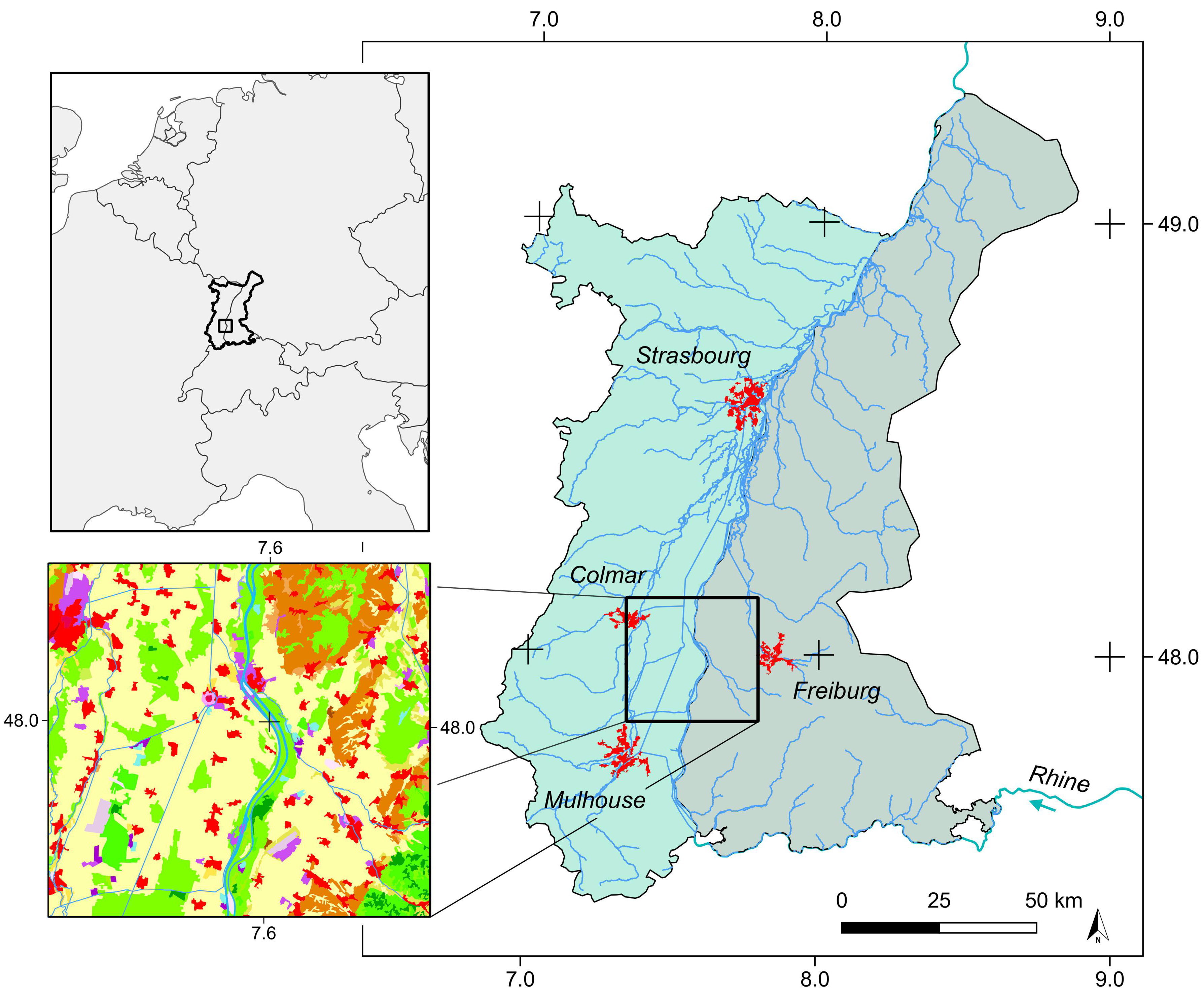
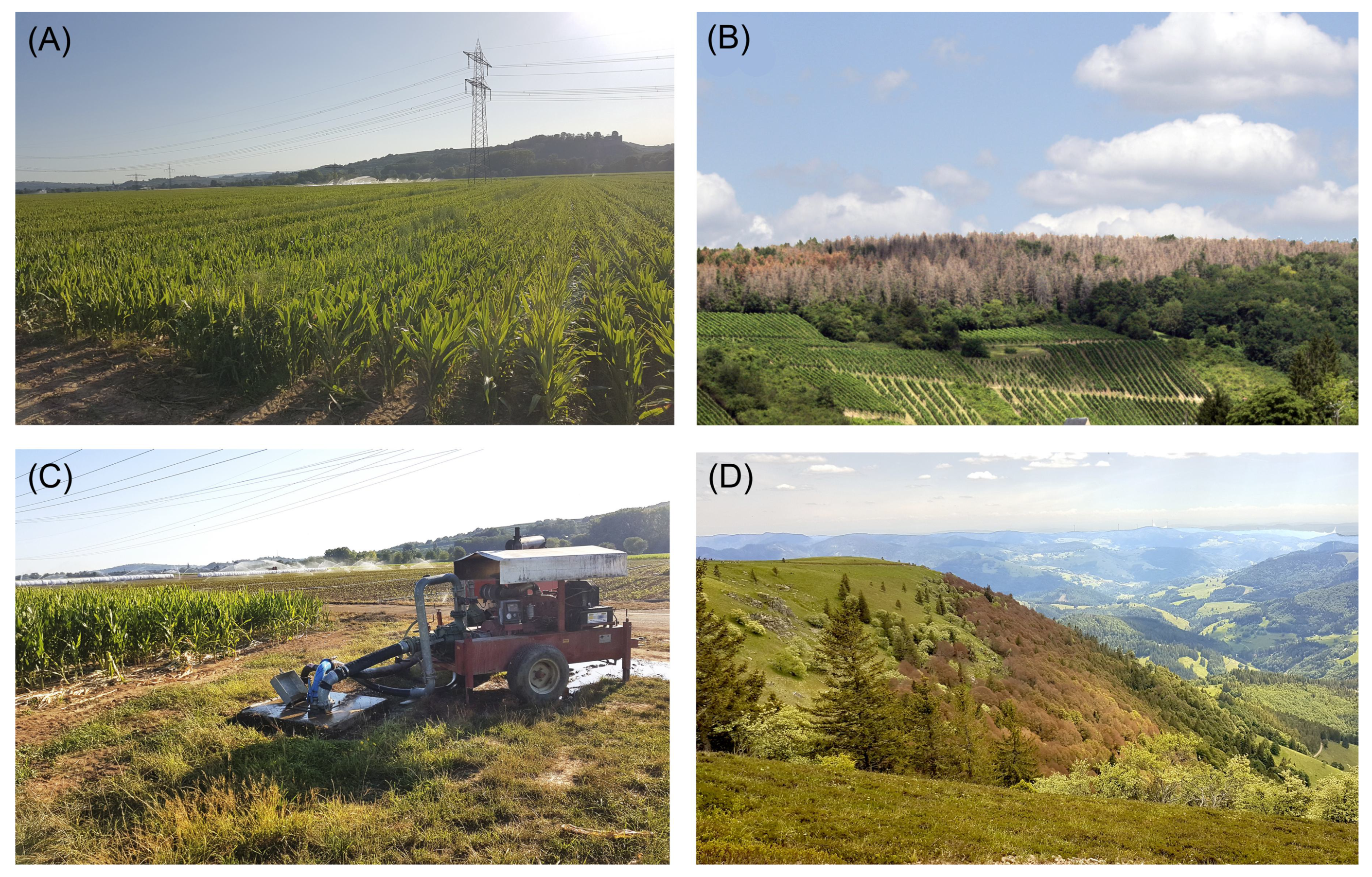
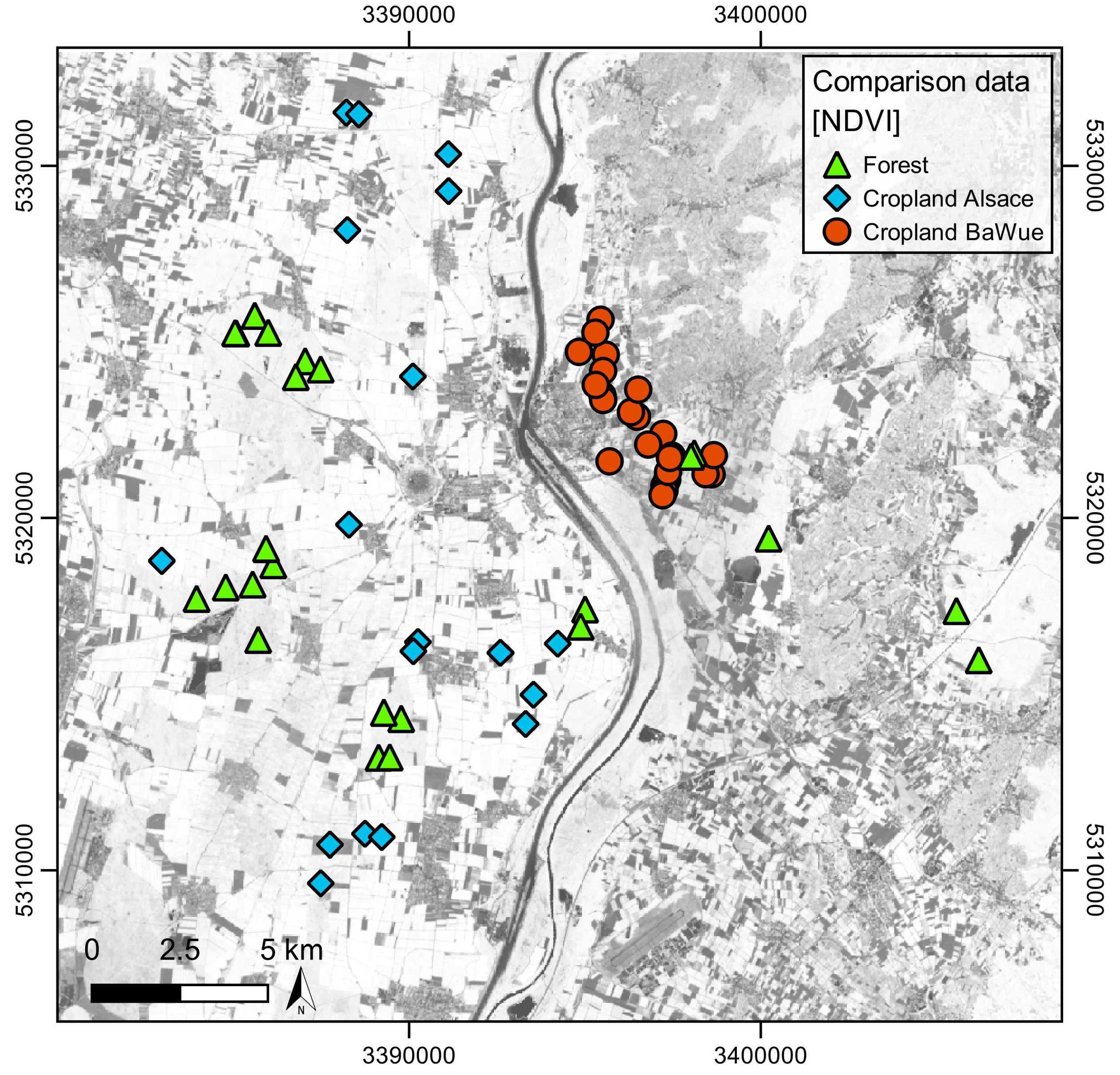
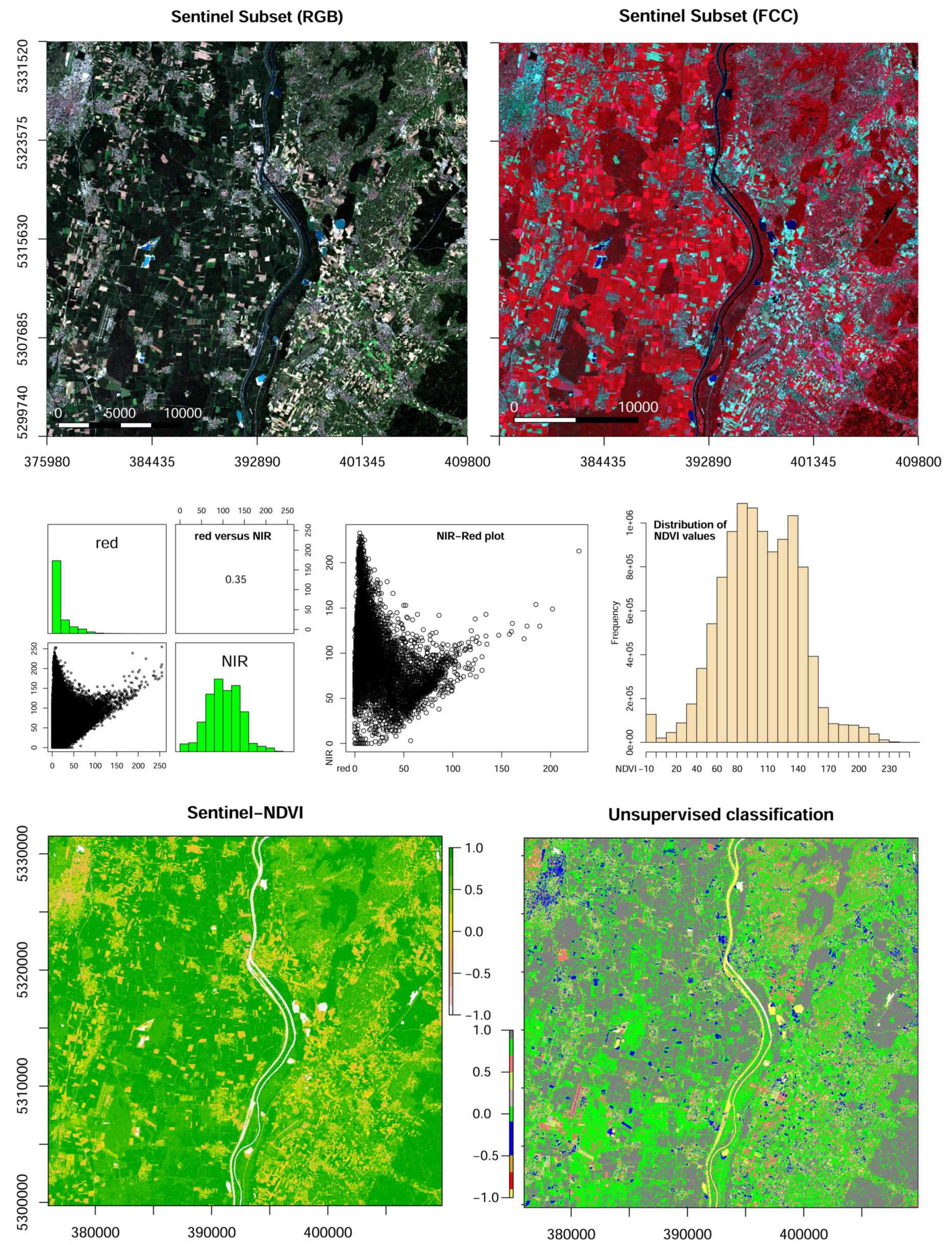


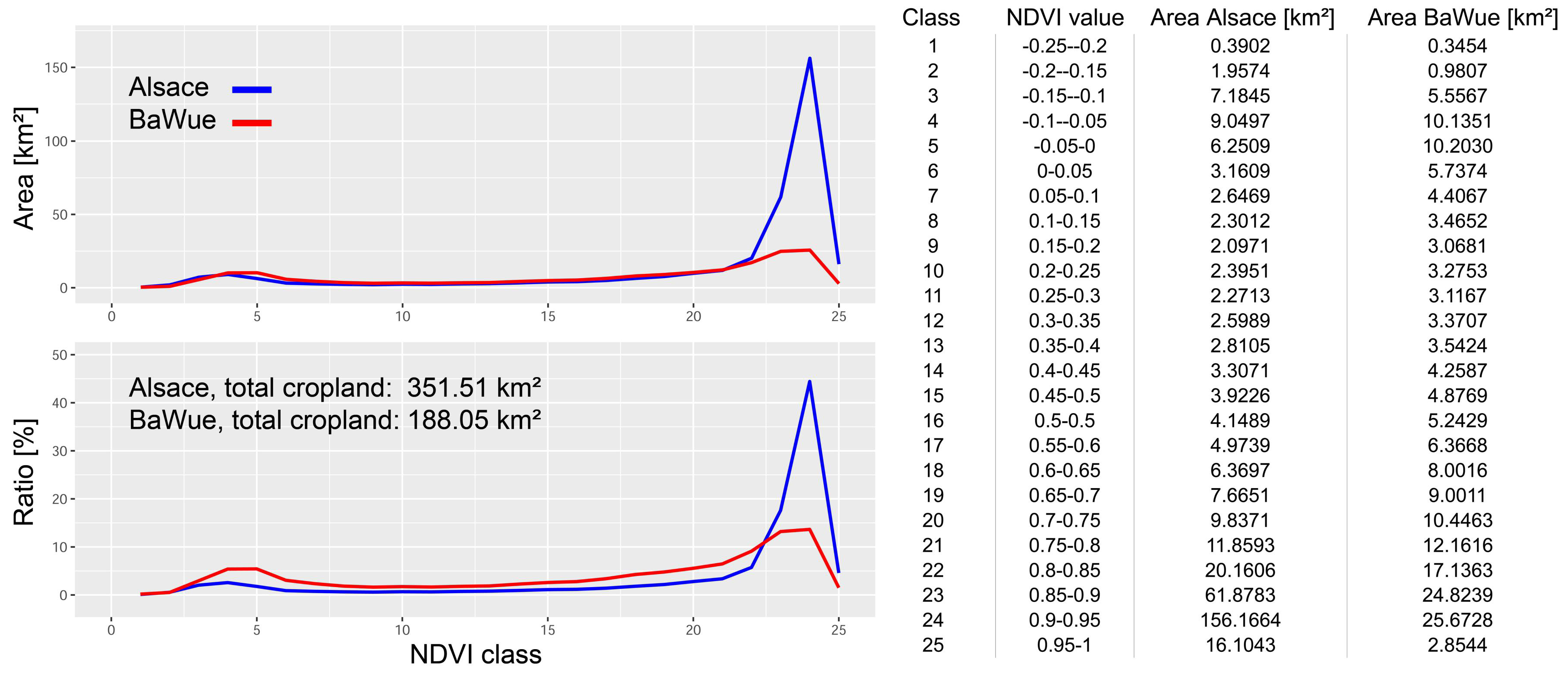
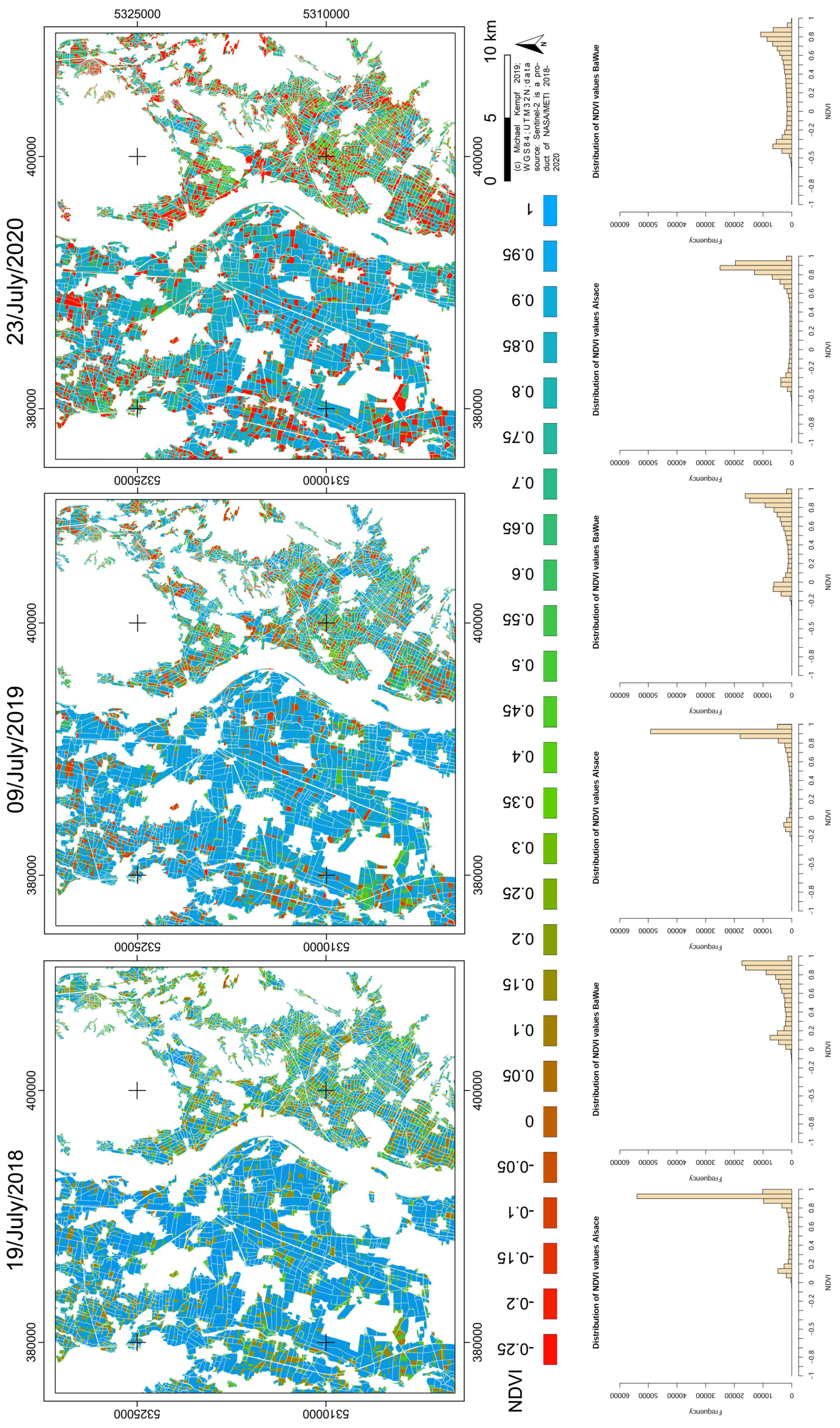
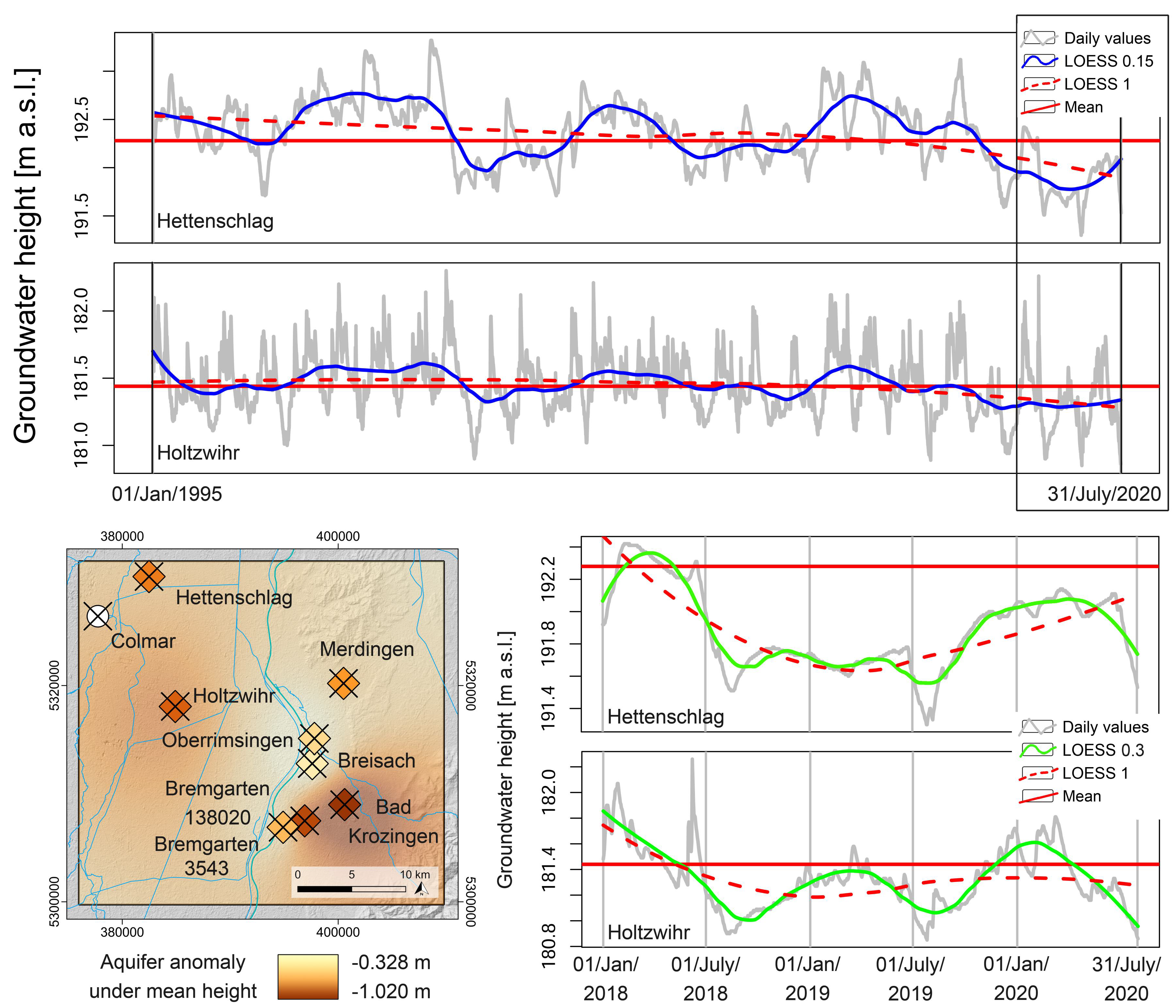
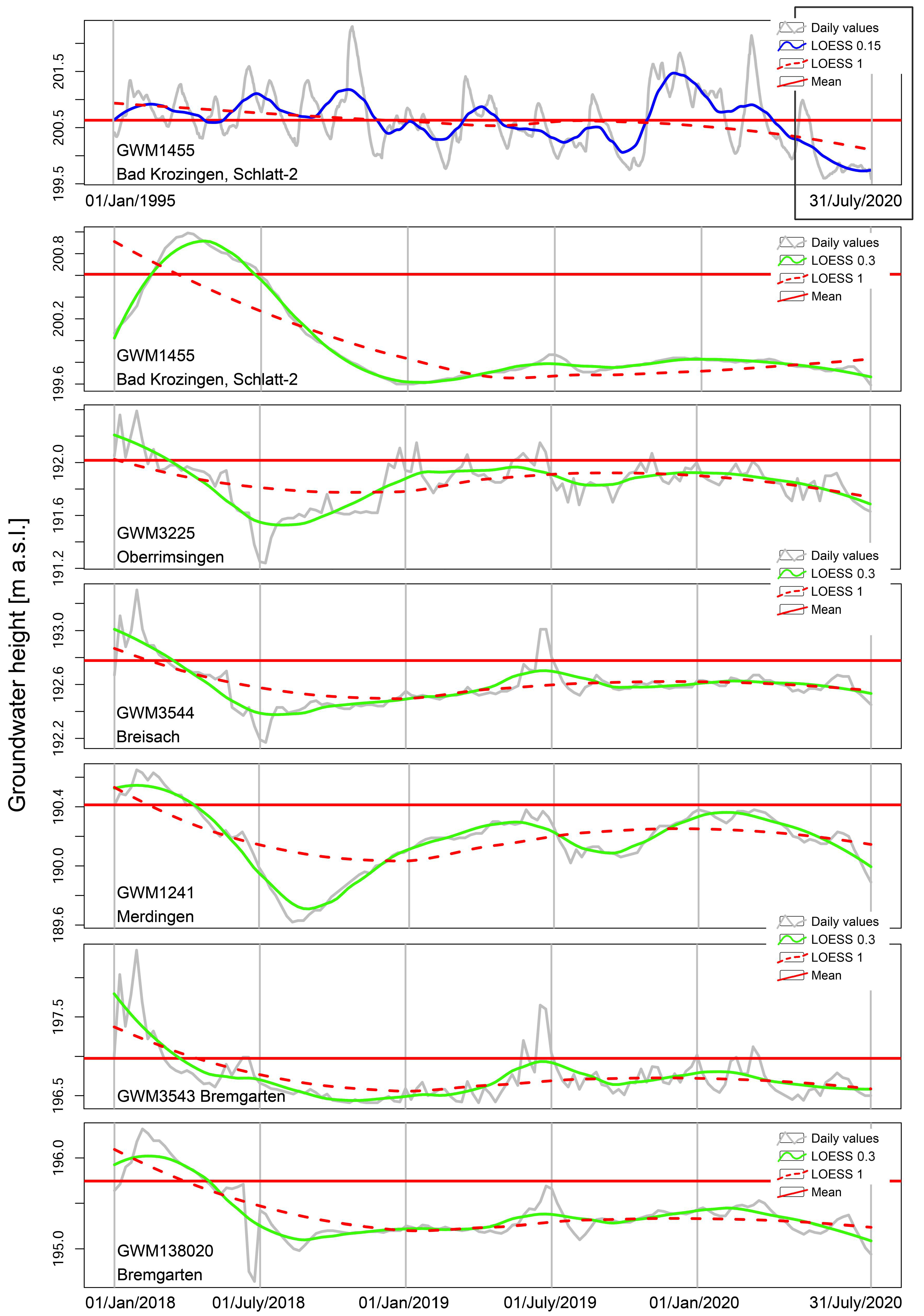
| Landsat-7 scene-id | WRS Path | WRS Row | Date |
| LE71950272000225EDC00 | 195 | 27 | 12/Aug/2000 |
| LE71950272001227NSG00 | 195 | 27 | 15/Aug/2001 |
| LE71960272002189NSG00 | 196 | 27 | 08/July/2002 |
| LE71950272003217EDC02 | 195 | 27 | 05/Aug/2003 |
| LE71950272004204ASN01 | 195 | 27 | 22/July/2004 |
| LE71950272005222EDC00 | 195 | 27 | 10/Aug/2005 |
| LE71960262006200ASN00 | 196 | 26 | 19/July/2006 |
| LE71950272007196ASN00 | 195 | 27 | 15/July/2007 |
| LE71960272008206ASN00 | 196 | 27 | 24/July/2008 |
| LE71960262009208ASN00 | 196 | 26 | 27/July/2009 |
| LE71960272010195ASN00 | 196 | 27 | 14/July/2010 |
| LE71960272011214ASN00 | 196 | 27 | 02/Aug/2011 |
| LE71960272012217ASN00 | 196 | 27 | 04/Aug/2012 |
| Landsat-8 scene-id | WRS Path | WRS Row | Date |
| LC08_L1TP_196027_20130714_20170503_01_T1 | 196 | 27 | 14/July/2013 |
| LC08_L1TP_196027_20140717_20170421_01_T1 | 196 | 27 | 17/July/2014 |
| LC08_L1TP_196027_20150704_20170407_01_T1 | 196 | 27 | 04/July/2015 |
| LC08_L1TP_196027_20160706_20170323_01_T1 | 196 | 27 | 06/July/2016 |
| LC08_L1TP_195027_20170718_20170727_01_T1 | 195 | 27 | 18/July/2017 |
| LC08_L1TP_196027_20180712_20180717_01_T1 | 196 | 27 | 12/July/2018 |
| LC08_L1TP_195027_20190724_20190801_01_T1 | 195 | 27 | 24/July/2019 |
| LC08_L1TP_196027_20200701_20200708_01_T1 | 196 | 27 | 01/July/2020 |
| Sentinel-2 tile-id | Date | ||
| S2B_OPER_MSI_L2A_TL_SGS__20180719T145501_A007141_T32ULU_N02.08 | 19/July/2018 | ||
| S2A_OPER_MSI_L2A_TL_MPS__20190709T140909_A021126_T32ULU_N02.13 | 09/July/2019 | ||
| S2A_OPER_MSI_L2A_TL_MPS__20200723T142801_A026560_T32ULU_N02.14 | 23/July/2020 | ||
Publisher’s Note: MDPI stays neutral with regard to jurisdictional claims in published maps and institutional affiliations. |
© 2020 by the authors. Licensee MDPI, Basel, Switzerland. This article is an open access article distributed under the terms and conditions of the Creative Commons Attribution (CC BY) license (http://creativecommons.org/licenses/by/4.0/).
Share and Cite
Kempf, M.; Glaser, R. Tracing Real-Time Transnational Hydrologic Sensitivity and Crop Irrigation in the Upper Rhine Area over the Exceptional Drought Episode 2018–2020 Using Open Source Sentinel-2 Data. Water 2020, 12, 3298. https://doi.org/10.3390/w12123298
Kempf M, Glaser R. Tracing Real-Time Transnational Hydrologic Sensitivity and Crop Irrigation in the Upper Rhine Area over the Exceptional Drought Episode 2018–2020 Using Open Source Sentinel-2 Data. Water. 2020; 12(12):3298. https://doi.org/10.3390/w12123298
Chicago/Turabian StyleKempf, Michael, and Rüdiger Glaser. 2020. "Tracing Real-Time Transnational Hydrologic Sensitivity and Crop Irrigation in the Upper Rhine Area over the Exceptional Drought Episode 2018–2020 Using Open Source Sentinel-2 Data" Water 12, no. 12: 3298. https://doi.org/10.3390/w12123298






